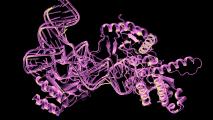A drug used to treat cancer appears to prevent the formation of brain aneurysms, too, according to a mouse study in Japan. If the results hold up in people, there might finally be a way to stop these “silent killers” that doesn’t require surgery.
Silent killers: Intracranial aneurysms are ballooned blood vessels in the brain, and they are so weak, they could burst at any time. They can be found in an estimated 5% of the population, but ruptures are relatively rare — in the US, there are about 30,000 cases every year.
The exact cause of brain aneurysms is unknown, and they usually go unnoticed until they rupture. When that happens, the risk of death within three months is 50%, and among those that do survive, two-thirds will have permanent brain damage.
It is possible to detect unruptured brain aneurysms through MRA and CTA scans, and once spotted, they can be repaired through surgery. Those procedures are incredibly risky, though, especially if the aneurysm is in a particularly sensitive part of the brain.
The risk of death within three months of a brain aneurysm rupturing is 50%.
What’s new? Researchers at the RIKEN Center for Brain Science (CBS) in Japan have now discovered that mutations in certain genes are common in the cells that make up aneurysmal arteries.
Armed with that knowledge, they conducted experiments that led to discovery that a common cancer medication can block the activity of one of the most common mutations and prevent the formation of aneurysms in mouse models.
“[W]e suppressed artery expansion with a drug, indicating that intracranial aneurysms can be pharmacologically treated,” said project leader Hirofumi Nakatomi.
How it works: The team started by sequencing DNA in 65 aneurysmal arteries and 24 normal arteries taken from human patients. This led to the discovery that 92% of the aneurysms had at least one mutation in a set of 16 genes. None of the normal arteries had these mutations.
There are two major types of brain aneurysms, and six of the mutant genes could be found in both types. When the researchers focused on those, they found that all six triggered NF-κB, a signaling pathway in the brain previously linked to brain aneurysms.
“We suppressed artery expansion with a drug.”
Hirofumi Nakatomi
One of the mutant genes (PDGDRB) could be found in multiple cell layers in some of the brain aneurysm samples, and through tests in the lab, the researchers learned that cells with this mutation migrated more quickly than normal and were more prone to inflammation.
Sunitinib, a cancer drug, is already known to inhibit the activity of the PDGDRB gene, which can help stop some cancers from proliferating, and the researchers showed that it was also able to prevent the abnormal activity in their cultured cells.
They then inserted a mutated PDGDRB gene into an artery in the brains of mice, and within a month, the artery was weakened and had doubled in diameter. But if they administered sunitinib to mice with the mutated gene, it prevented brain aneurysms from forming.
The caveats: Treatments that work in mice often fail in people, so it’s too soon to say whether sunitinib could prevent the formation of brain aneurysms in humans with the PDGDRB mutation.
Even if it does, that specific mutation wasn’t present in all of the brain aneurysm samples — it’s possible sunitinib could have the same positive effect on other mutations, but again, it’s too soon to say.
Perhaps the biggest caveat, though, is that we rarely know that a person is at risk of developing a brain aneurysm until it’s already formed and ruptured. If an aneurysm is already formed and is detected in a scan, we don’t know if sunitinib can shrink or stabilize it — that’s yet another question that needs to be studied.
One of the first uses for the drug could be to prevent aneurysm recurrences.
Looking ahead: Even if the sunitinib research doesn’t translate to people, the new technique for creating mouse models of brain aneurysms is in itself a major achievement, according to Nakatomi.
The current method for studying aneurysms requires researchers to induce hypertension in the animals, alter their blood flow, and inject an enzyme into a blood vessel — the ability to swap all that out for a single injection of a mutated gene could make it easier to conduct aneurysm research. These aneurysms might also more closely resemble those that form in humans.
If sunitinib can prevent aneurysms in people, Nakatomi told Fierce Biotech that one of the first uses for it could be to prevent recurrences in people who’ve already undergone surgery to have an aneurysm repaired — about 20% of people who survive one aneurysm develop another.
We’d love to hear from you! If you have a comment about this article or if you have a tip for a future Freethink story, please email us at [email protected].






